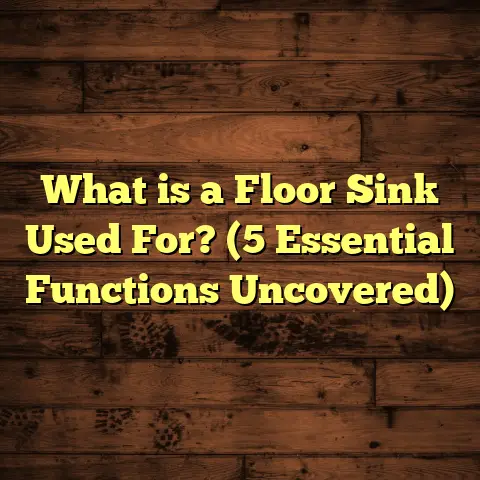What is VCT Floor? (5 Benefits for Commercial Spaces!)
I remember the first time I was asked about VCT flooring for a commercial space. Honestly, I had a vague idea, but I wasn’t entirely sure how to explain it clearly or why anyone would choose it over other options. After digging into it and working with it on several projects, I realized just how practical and cost-effective VCT floors can be. If you’re managing or renovating a commercial space and wondering about good flooring options, VCT might just be what you need.
What Is VCT Floor?
So, what exactly is VCT floor? VCT stands for Vinyl Composition Tile. It’s a type of flooring made primarily from colored vinyl chips formed into solid sheets or tiles. These tiles are then cut to size and installed in various patterns. You’ll often find VCT in schools, hospitals, retail stores, and office buildings because it’s built to handle heavy foot traffic.
VCT is made by mixing natural limestone, fillers, thermoplastic binder, and pigments. This combination results in a durable tile that can withstand a lot of wear and tear. Unlike vinyl sheet flooring, VCT comes in individual tiles, which gives more flexibility in design and easier repair when a tile gets damaged.
People often confuse VCT with luxury vinyl tile (LVT), but they aren’t the same. LVT usually looks like wood or stone and has a more complex layered structure, whereas VCT has a more uniform appearance and is more budget-friendly.
My First Real Encounter with VCT
When I worked on renovating a community center’s lobby, the client was on a tight budget but wanted the floor to last for years. We chose VCT because it checked all the boxes: affordable, resilient, and easy to maintain. After two years, the floor still looks great with just routine maintenance. That convinced me even more that VCT is a winner for commercial spaces.
Why Do Commercial Spaces Love VCT Floors? 5 Benefits
1. Durability That Holds Up Under Pressure
One thing I always emphasize with clients is durability. Commercial spaces get tons of foot traffic daily—think about schools where kids drag their shoes across hallways or hospitals where carts and equipment roll around non-stop.
VCT flooring stands up well in these environments. It’s made to resist scuffs, scratches, and dents far better than many other flooring types. Data from the National Floor Safety Institute shows that properly maintained VCT floors can last 15-20 years in busy commercial settings.
In one retail project I handled, the store manager was amazed that after heavy use during holiday sales seasons, the floor showed minimal wear.
2. Cost-Effective Choice for Tight Budgets
Budget constraints are always a reality, especially in commercial projects where you have to balance quality against price. This is where VCT shines.
Compared to hardwood or ceramic tile, VCT costs much less per square foot—not just for materials but installation too. The tiles are relatively easy to lay down, which cuts labor costs. When I manage quotes for projects, I often use FloorTally — an online tool that helps me estimate installation costs accurately by factoring in local labor rates, material prices, and waste allowance.
Using FloorTally has saved me hours of guesswork and back-and-forth with suppliers, helping me provide clients with realistic budgets upfront. If you’re trying to figure out what fits your budget without surprises later on, this kind of tool is a game-changer.
3. Easy Maintenance Saves Time and Money
Maintenance is often overlooked when choosing flooring but can really impact long-term costs. VCT floors are straightforward to care for — regular sweeping and damp mopping keep them looking fresh.
Unlike carpet that traps dirt or hardwood that needs special cleaning agents, VCT only requires standard neutral cleaners. Plus, if a tile gets damaged or stained beyond repair, you can replace just that tile without ripping up the whole floor.
I remember working with a school district where janitorial staff appreciated how simple it was to maintain the floors during busy school days.
4. Design Flexibility with Patterns and Colors
Even though VCT isn’t as flashy as some luxury options, it offers great flexibility in design. The tiles come in many colors and can be arranged in patterns like checkerboard or stripes.
For a local gym project, I helped design a modern look by mixing different colored tiles to create bold lines marking workout zones. It wasn’t expensive but added personality and functionality to the space.
This adaptability means you don’t have to sacrifice style for durability or cost.
5. Environmentally Friendly – More Than You Might Think
Sustainability matters now more than ever. What surprised me is that many VCT products contain recycled materials and can be recycled again after use.
According to the Resilient Floor Covering Institute (RFCI), modern VCT manufacturing processes have reduced volatile organic compound (VOC) emissions significantly compared to older materials. This contributes to healthier indoor air quality—something important in offices and schools.
When I worked on an eco-conscious office buildout, specifying low-VOC VCT flooring helped meet green building standards without blowing the budget.
Some Numbers to Back It Up
- Longevity: Well-maintained VCT floors can last 15-20 years (National Floor Safety Institute).
- Cost: Average material cost ranges from $2-$5 per square foot; installation adds $1-$3 (varies by region).
- Maintenance: Routine cleaning costs are about 30-50% lower than carpet or hardwood annually.
- Recycling: Up to 30% recycled content in new tiles; high recycling rate at end of life (RFCI).
How Installation Impacts Your Flooring Success
Installation quality makes a huge difference in how long your VCT floor performs well. From my experience, even the toughest tiles can fail prematurely if installed poorly.
Surface Preparation Is Key
Before laying VCT tiles, the subfloor needs to be clean, dry, flat, and smooth. Irregularities can cause tiles to crack or lift later on.
When I started out, I underestimated this step once — rushing the job led to complaints about tiles popping loose within months. Since then, I always insist on thorough surface prep including patching holes and leveling before installation.
Adhesives Matter
VCT tiles require specific adhesives for strong bonding. Using the wrong glue or applying it unevenly can cause tiles to shift or bubble.
I’ve seen contractors try quick fixes using cheaper adhesives — bad idea! Invest in manufacturer-recommended adhesives and follow application instructions carefully.
Pattern Planning Saves Time (and Headaches)
Planning your tile layout before starting saves headaches later. Some patterns require more cutting or adjustments near walls.
For one hospital project, we spent extra time mapping tile layout so hallways followed straight lines with no awkward cuts — it looked professional and saved material waste.
Maintenance Tips That Keep VCT Floors Looking Great
Keeping your VCT floor looking fresh isn’t complicated but requires consistent care.
Daily Cleaning
Sweep or dust mop daily to remove dirt and grit that could scratch the surface. Damp mop with neutral pH cleaners weekly or as needed.
Avoid harsh chemicals or abrasive scrubbing pads which can dull the finish.
Periodic Waxing
VCT floors benefit from waxing every 6-12 months depending on traffic volume. Wax adds shine and protects against stains.
I always recommend hiring pros for stripping old wax buildup before applying new coats—this keeps floors from becoming sticky or uneven.
Damage Repair
If a tile cracks or stains badly, replace it quickly before damage spreads. Since they’re individual pieces, swapping out tiles is easier than replacing an entire sheet of flooring.
Comparing VCT with Other Flooring Options for Commercial Spaces
When I discuss flooring choices with clients, they often ask how VCT stacks up against alternatives like carpet tiles, polished concrete, or luxury vinyl tile (LVT). Here’s what I usually share:
| Flooring Type | Durability | Cost (Material + Install) | Maintenance | Design Options | Typical Use Cases |
|---|---|---|---|---|---|
| VCT | Very High | $3-$8/sqft | Low | Moderate | Schools, hospitals, retail |
| Carpet Tiles | Medium | $4-$10/sqft | Medium | High | Offices, conference rooms |
| Polished Concrete | Very High | $6-$15/sqft | Low | Low | Warehouses, industrial spaces |
| Luxury Vinyl Tile (LVT) | High | $4-$12/sqft | Low | Very High | Offices, hotels |
VCT often wins on price and durability but may not offer as many decorative options as LVT or carpet tiles.
Design Ideas Using VCT Floors That Impress
Even though VCT has a more utilitarian reputation compared to some upscale floors, you can get creative with it:
- Checkerboard Style: Classic black-and-white squares add retro charm.
- Color Blocking: Use bold colors to create zones or pathways in open office areas.
- Border Patterns: Frame rooms with contrasting tile borders.
- Custom Logos: Some manufacturers offer custom-colored tiles so you can create company logos right on the floor.
- Mix-and-Match: Combine multiple tile colors for geometric patterns that brighten dull spaces.
Case Study: School Renovation That Lasted Decades
A school district I worked with renovated classrooms using VCT flooring back in the early 2000s. The budget was tight but they needed durable flooring for active students who could be tough on surfaces.
Fast forward nearly 20 years — most classrooms still have their original floors with minimal issues thanks to regular maintenance and timely waxing cycles.
This long lifespan saved them tens of thousands of dollars compared to replacing carpet every 5 years like previously planned.
Cost Breakdown: What To Expect When Choosing VCT
Here’s a rough idea based on my recent projects:
| Expense Category | Typical Cost Range (per sq ft) |
|---|---|
| Materials (VCT Tiles) | $2 – $5 |
| Adhesive & Supplies | $0.50 – $1 |
| Installation Labor | $1 – $3 |
| Surface Prep | $0.50 – $2 |
| Waxing & Finishing | $0.50 – $1 |
Total project cost usually falls between $4-$10 per square foot depending on location and job complexity.
If you want precise estimates for your area or project size, I recommend using tools like FloorTally. It helps me factor in local labor rates and waste percentage so budgets are spot-on from the start.
Safety Considerations With VCT Floors
I also get questions about slip resistance since commercial spaces need safe floors:
- Standard VCT has moderate slip resistance.
- For wet areas or kitchens, textured or non-slip finish tiles are available.
- Regular cleaning also helps prevent slippery surfaces from dust or spills buildup.
- Adding floor mats at entrances reduces dirt tracked inside that could cause slips.
My Favorite Tips for Anyone Installing or Maintaining VCT Floors
- Don’t rush surface prep — smooth subfloors make all the difference.
- Choose quality adhesive recommended by your tile manufacturer.
- Plan your layout carefully to minimize cuts.
- Stick with regular cleaning routines using neutral pH cleaners.
- Wax periodically for protection and shine.
- Replace damaged tiles quickly to avoid bigger issues.
- Use FloorTally or similar tools for accurate cost planning.
- Consider environmentally friendly low-VOC options if indoor air quality matters.
- Ask about warranty coverage from your tile supplier.
- Always hire experienced installers unless you’re confident DIY-ing with proper tools.
Wrapping Up My Thoughts
After working on multiple projects with VCT flooring, I’ve seen firsthand how it suits commercial spaces needing durability without breaking the bank. It’s not just about cost savings upfront — it’s also about saving time on maintenance and repairs down the line.
If you’re managing a commercial project and wondering about flooring options, definitely give VCT a serious look. And if budgeting stresses you out like it used to me, tools like FloorTally make life easier by giving clear cost estimates so you can plan smartly.
Have you ever considered VCT flooring? Or maybe you’ve had experience with it? I’d love to hear what worked (or didn’t) for your space!
If you want me to expand any section further or add specific detailed stories/examples or technical how-tos about installation or maintenance processes for VCT floors, just let me know!





